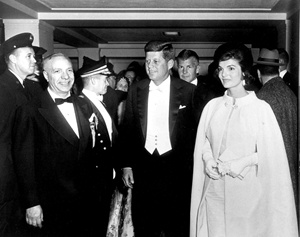Photograph of Senator John F. Kennedy and Jacqueline Sailing on the 'Victura'
Photograph of Senator John F. Kennedy and his fiancée Jacqueline Bouvier sailing the Victura on the waters off the coast of Hyannis Port, Massachusetts.
Bequest of the Estate of President John F. Kennedy
"The Inquiring Camera Girl" Camera
Camera Jacqueline Bouvier used as the $42.50-per-week reporter and photographer for the Washington Times-Herald. She began work as "The Inquiring Camera Girl" for the paper in 1952 at the age of 23, roving the city to capture people's opinions on a variety of topics. The young reporter used this camera to photograph those she interviewed. An April 1953 installment of her column featured Senator John F. Kennedy and Vice President Richard M. Nixon.
John F. Kennedy Presidential Library and Museum, Boston, MA. Accession number MO 63.6106
White House Guide Book
To avoid the politically controversial use of public money for the restoration of the White House State rooms, Mrs. Kennedy established the White House Historical Association which would publish the first official White House Guidebook in 1962. All profits from the sale of the guidebook to the millions who toured the White House would be used to fund the restoration project and to purchase the furnishings and other historic materials located by the Fine Arts Committee. Together with the newly appointed White House Curator (a position whose creation Mrs. Kennedy championed), Mrs. Kennedy approved the guidebook's text, chose which photographs would be featured, and designed the book's layout. Upon publication, it became an immediate success.
Rendering of the White House Treaty Room
In 1961 Jacqueline Kennedy appointed a Fine Arts Committee to restore the interiors of the White House. The committee was chaired by Henry Francis du Pont, the nation's leading collector of American antiques. To help with the interior design, First Lady Jacqueline Kennedy hired Stephane Boudin, a French designer with the Maison Jansen decorating firm.
When the work was complete she commissioned artist Edward Lehman to create a series of watercolors of the restored White House interiors. She had admired Lehman's sleek pen-and-ink studies in an article on the progress of the White House project in the Philadelphia Inquirer.
John F. Kennedy Presidential Library and Museum, Boston. Accession number MO 63.2038
Copyright Estate of Edward Lehman
Jacqueline Kennedy's Emmy Award
Affectionately known as the Emmy, this award was presented to First Lady Jacqueline Kennedy for her television tour of the White House that aired on CBS in February of 1962. A statuette of a winged woman holding an atom became the symbol of the TV Academy's goal of supporting and uplifting the arts and science of television: the wings represent the muse of art; the atom the electron of science.
John F. Kennedy Presidential Library and Museum, Boston, MA. Accession number MO 74.385
The White House Long Ago, MO 63.2145
Watercolor painting of the White House with horses on a path and figures on the lawn in the foreground, painted by Jacqueline Kennedy c. 1962 and given to her husband as a gift. The President chose to display this painting in his Oval Office of the White House.
John F. Kennedy Presidential Library and Museum, Boston, MA. Accession number MO 63.2145
Copyright restrictions, reproduction prohibited.
Trompe L'Oeil Left Door (Mes Objects Adore)
One of two wardrobe doors painted in trompe l'oeil style by Pierre Marie Rudelle (French, 1932 - 2015) with favorite objects of First Lady Jacqueline Kennedy. These doors were originally used in Jacqueline Kennedy's White House dressing room.
John F. Kennedy Presidential Library and Museum, Boston, MA. Accession number MO 2009.3.83.6
Statue of a Striding Man, Old Kingdom, 5th Dynasty (2450-2290 B.C.E.)
This statue was presented to President and Mrs. Kennedy by Egyptian President Gamal Abdel Nasser in gratitude for their work to save the temples of Abu Simbel. First Lady Jacqueline Kennedy helped to organize international support to move the temples before they were forever lost by the flooding of the Nile during construction of the Aswan Dam. The three-foot Egyptian statue was presented to her by the government of Egypt at the opening of the King Tutankhamen exhibit in Washington, D.C., on November 3, 1961.
John F. Kennedy Presidential Library and Museum, Boston, MA. Accession number MO 95.72

